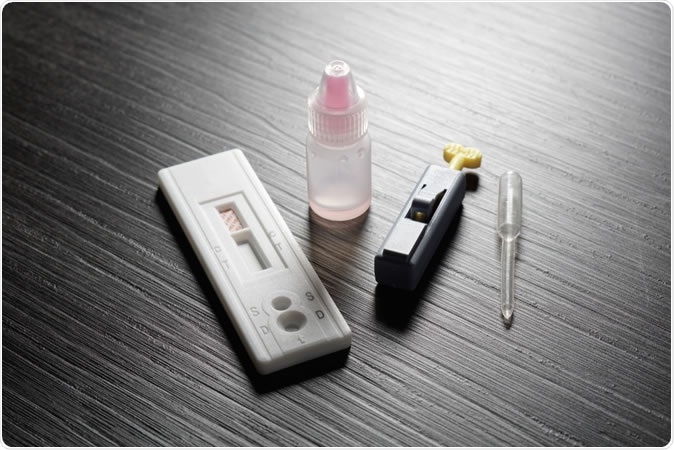Men who have sex with men (MSMs) are among the most high-risk groups for acquiring and transmitting HIV infection. A new study published in the journal JAMA Internal Medicine says that the rate of detection of new infections is more than doubled when self-testing is available. This could increase access to early treatment and thus interrupt the chain of transmission among MSMs.
There are several categories of MSMs including homosexual, bisexual and others. This group is responsible for over 66% of new HIV infections. However, about 1 in 6 of this extremely high-risk group has never been tested for the infection.
Earlier studies have shown that self-testing for HIV is a safe and acceptable method of diagnosis and will increase detection rates. However, self-testing also carries the risk that the healthcare system remains unaware of the individual’s HIV status, which could pose a barrier to care. Secondly, if done just before intercourse, a false-negative test could actually increase the risk of transmission. And finally, cost has been reported to be an issue.
The study
The current study was sponsored by the Centers for Disease Control and Prevention (CDC), and is called Evaluation of Rapid HIV Self-testing Among MSM Project (eSTAMP). It is designed to answer the question, “Does provision of HIV self-tests to internet-recruited men who have sex with men increase HIV testing and diagnosis of infection over a 12-month period?”
There were more than 2,600 participants who were recruited via internet advertising, completed eligibility forms and reported being negative for HIV at the start of the trial. There were all male, had a male sexual identity, were adults, had anal sex with at least one man over the last 12 months, were HIV negative and had not received HIV vaccine or antiretroviral drugs to prevent HIV.
All were provided with access to telephone counseling and HIV testing services at local centers. They were then randomized into two groups, one of which comprised the self-testing arm and the other the control arm. The first group was sent 2 self-testing HIV kits based on oral fluid, and 2 based on whole blood obtained by fingerstick. Instructions on their use were also provided.

HIV Rapid Test Kit. Credit: Mohd Syis Zulkipli / Shutterstock
They could do the tests at whatever frequency they chose: they could order more as replacement or if they gave away kits to others in their network. When a positive HIV test was self-reported, or at the end of the trial, all participants (self-testing and control arms) were given a dried blood spot (DBS) test kit, 1 oral fluid kit and 1 fingerstick whole blood kit. The DBS cards mailed in by the participants were sent in to the CDC laboratories for analysis.
The results
Self-testing resulted in significantly more frequent testing for HIV compared to controls, with a mean of 5.3 and 1.5 tests over 12 months, respectively. In terms of percentage, over 75% of self-tested individuals tested themselves 3 or more times before the trial ended, compared with 22% of controls.
The total number of newly detected infections was 36, of which 14 were in the first 3 months. Among these, 12 came from the self-testing arm. Over the 12-month period, 25 new infections were detected in the self-testing group compared to 11 of the controls. 17 of the total new infections were in participants who had never been tested at all or had not been tested in the last year. Only 72% of these newly diagnosed individuals approached the healthcare system, however, for treatment and care.
The final DBS tests showed another 5 infection in the self-testing and 3 in the control arms, bringing the grand total to 44. However, DBS cards were mailed in from only 18 of these participants, making this finding a potential source of error.
38 people in the self-testing group gave away kits to other people in their social networks, yielding 52 new cases. 29 of these did not know that they were HIV positive till that time. About a third of these came in the first 3 months. Thus, the pickup rate for new infection was higher among the social network members than in the study group itself.
Overall, the trial showed an increase in yearly HIV testing rates by over 55% in the self-testing group – that is, from an initial 61% to a final 95%. Among controls, the increase was only 7%, from about 60% to 63%. Almost all the self-testing group individuals tested at least once, but about 66% of controls.
Implications and limitations
The trial thus shows that HIV self-testing can increase efficiency, reduce physician time and testing costs required to order and evaluate a test, and avoid fears of stigmatization and personal interactions. Intensive follow-up is also mandatory to achieve a high retention rate, that is, to make sure that people who test positive report the test and initiate healthcare.
There is not much benefit in terms of avoiding high-risk sexual behaviour, however, which indicates a fundamental failure to strike at the root of the HIV epidemic, while chopping away at twigs and branches. When detection of new HIV infection is not followed by treatment and prevention of transmission, the utility of detection is itself a moot point.
Journal reference:
MacGowan RJ, Chavez PR, Borkowf CB, et al. Effect of Internet-Distributed HIV Self-tests on HIV Diagnosis and Behavioral Outcomes in Men Who Have Sex With Men: A Randomized Clinical Trial. JAMA Intern Med. Published online November 18, 2019. doi: https://doi.org/10.1001/jamainternmed.2019.5222